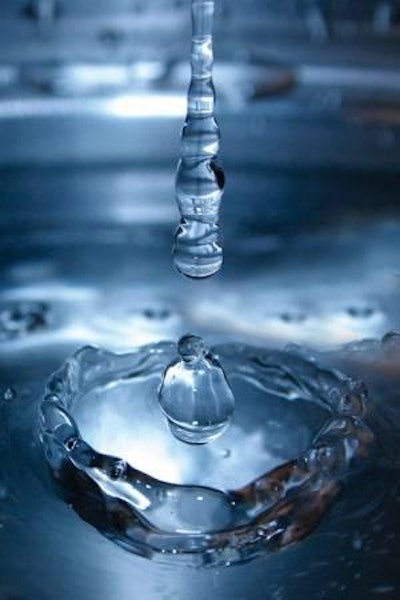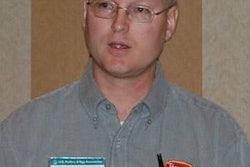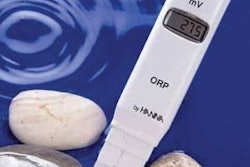
Good environmental management is about more than treating wastewater. The U.S. Poultry & Egg Association recently selected four poultry processing plants as the winners of the 2008 Clean Water Awards. Tyson Foods plants in Cumming and Dawson, Ga.; the Simmons Foods plant in Jay, Okla., and the Sanderson Farms plant in Moultrie, Ga., were each recognized. These plants all do an outstanding job treating wastewater, but they have also found other ways to economically protect both the environment and their companies' bottom lines.
The Tyson Foods broiler processing plant in Cumming, Ga., was meeting its effluent treatment limits for its wastewater, but the company has gone further with its programs. Eric Maltman, wastewater treatment plant manager, and Randy Payne, complex environmental manager, have found ways to reduce treatment costs while removing more nutrients from the plant's effluent.
The Cumming processing plant slaughters 260,000 head of 6-pound broilers per day. The plant has aggressively pursued water conservation and reuse, reducing water purchases by over 0.5 million gallons per day, and the plant now discharges only 1.2 million gallons per day of effluent.
Wastewater treatment begins at the processing plant where the offal screens and the flow equalization basin are located. The wastewater is then pumped three-quarters of a mile to the site of the wastewater facility. The treatment system consists of two dissolved air flotation (DAF) tanks, a 2.5 million gallon covered anaerobic tank, a 2.5 million gallon aerobic tank, an oxidation ditch and the clarifier.
A few years ago, Maltman and Payne wondered if they could control the dissolved oxygen level in their treatment system at some point so that they could get biological nitrification and denitrification to occur at the same time. Achieving this would reduce chemical costs and remove more nutrients. After reviewing Cumming's treatment system, they decided that the oxidation ditch, which had been used as a nitrification basin for 20 years, could be operated in a dissolved oxygen range that would promote both nitrification and denitrification. By doing this, the oxidation ditch could be used as an anoxic polishing reactor, since another reactor was available for nitrification. They decided to reconfigure the wastewater system from a two-stage system into a full three-stage Bardenpho system.
How it works
When biological nitrification and denitrification of wastewater are plotted against dissolved oxygen concentration, there is a dissolved oxygen concentration where these two processes intersect. Within one week of the system change at Cumming, effluent nitrate levels dropped from a historical range of 30 to 50 milligrams per liter to less than 10 milligrams per liter. By adding an additional carbon source, the nitrate concentration has been dropped as low as 2 milligrams per liter. Bio-phosphorus removal that takes place during treatment has allowed Tyson to reduce alum usage by 50 percent and produce treated effluent with a phosphorous concentration of 0.5 milligrams per liter or less. Bio-phosphorous removal also reduces the amount of sludge produced, saving money for sludge disposal.
No capital funding was used in this conversion, but Payne said that it would not have been possible without the Supervisory Control and Data Acquisition (SCADA) system.
The SCADA system has become one of the most important elements in the operation of the wastewater treatment system at Cumming, according to Payne. "It has revolutionized the bio-phosphorous and denitrification processes and has created a paradigm shift from a manual operations mode to a verification mode," he said.
Tyson Foods, Cumming, Ga., was selected by the U.S. Poultry & Egg Association as the winner of its 2008 Clean Water Award for full-treatment facilities.
Sanderson Farms opened its Moultrie, Ga., broiler processing plant in the summer of 2005. The plant uses around 1.5 million gallons of water per day to process 252,000 head of 6-pound broilers.
Sanderson operates a Schreiber system that does not use a DAF. Screened wastewater goes straight into a covered anaerobic lagoon. The membrane cover, which costs around $1 million, allows for the collection of methane produced in the lagoon. Sanderson is analyzing the gas at one of its other locations and looking at whether it is best used to fuel boilers or to run a generator to produce electricity and hot water.
After the anaerobic lagoon, the effluent goes through an anoxic basin, an aeration basin, clarifier, and then a holding pond at the spray fields. The treated effluent is used to irrigate 400 acres of Alicia Bermuda grass which is raised for hay. In winter, the fields are over seeded with rye grass. A sprinkler system is used to distribute the treated wastewater.
Performance of the treatment system has been outstanding and the effluent has very low nutrient levels after treatment. The Moultrie plant was named the runner-up in the full-treatment category.
Jay Custom Processing, Jay, Okla., owned by Simmons Foods, Inc., processes spent broiler breeder hens and roosters. This facility is one of four major spent-hen plants in the USA, processing birds from 11 states. Around 68,000 spent breeders with an average weight of 8.25 pounds per bird are processed each day.
The evisceration department at Jay looks like a cross between a turkey plant and a broiler plant, and many jobs are done by hand. One important part of the process is removing the reproductive tract of the hens in a manner that keeps the eggs and egg yolks out of the wastewater. After chilling, the birds are cut-up and sold to another processor who cooks them.
The facility operates a wastewater pretreatment plant and treats around 500,000 gallons of water per day. After screening, the wastewater goes to a Dorr Oliver Vacuator, which was installed at the facility in 1953. The Vacuator is the predecessor of the modern DAF, and this is believed to be the last Vacuator in use in the USA. This Vacuator consists of an enclosed concrete tank, a recycle pump, a vacuum pump, a skimming removal system and a skimming pump. Raw wastewater is dosed with ferric sulfate and cationic polymers prior to entering the tank where it is lifted eight feet by maintaining seven inches of vacuum within the tank. The negative pressure in the tank helps release the gases and dissolved air from the wastewater and aids with floating the solids, producing a well clarified effluent and thick sludge.
Andy Brashear, director of environmental quality, Simmons Foods, said that the vacuum level in the tank has to be monitored and adjusted by the operator. "You have to adjust the vacuum pressure as the weather and the barometric pressure change." Working with a somewhat finicky piece of equipment does have its rewards; this unit achieves 95 percent removal of biological oxygen demand (BOD) and the plant has a six-year track record of 100 percent permit compliance.
The Vacuator used to belong to the city of Jay, but the company took it over in the mid-1980s. The plant's effluent makes up 80 percent of the town's water flow, and they discharge just a tiny percentage of the allowable amounts of nutrients. Water usage in the processing plant has been reduced by over 200,000 gallons per day as a result of water conservation and reuse efforts.
Jay Custom Processing, Jay, Okla., was selected as the winner of the 2008 Clean Water Award for pretreatment facilities.
The Tyson Foods further processing plant in Dawson, Ga., produces 500,000 pounds per day of par-cooked product for Wendy's Old Fashioned Hamburgers quick service restaurants. This facility is dedicated to producing nuggets and breaded filets for sandwiches for Wendy's. Product is tumbled with marinade, breaded, par-fried, chilled, batched and bagged on continuous lines. Bags of product are sized so that a whole bag of product can be placed in the fryer at the restaurant.
Meat is received at the Dawson plant in cardboard bins from sister plants. Dawson has started a corrugated recycling program. James Scalcucci, environmental manager, Tyson Foods, Dawson, Ga., said that the cardboard recycling program is expected to save the company around $250,000 per year. The savings comes from the money Tyson is paid for the corrugated and the tipping fees that they no longer pay the landfill. This program will cut their trash volume in half.
The Dawson plant only uses around 200,000 gallons of water per day. Treatment consists of a screen, equalization basin, a DAF to float out the flour, an aeration basin, a second DAF and then discharge to city treatment system. Scalcucci explained that timers were installed on the skimmers for the DAF units to turn the skimmers on and off. This allows for a thicker sludge blanket to form between removal cycles, which has decreased the amount of sludge that is land applied by around 40 percent and has saved $100,000 annually.
Tyson Foods, Dawson, Ga., plant was runner-up in the pretreatment category.
















